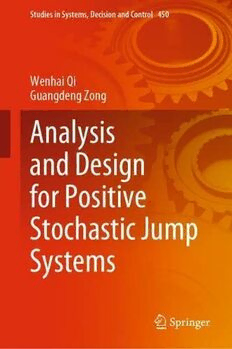Table Of ContentStudies in Systems, Decision and Control 450
Wenhai Qi
Guangdeng Zong
Analysis
and Design
for Positive
Stochastic Jump
Systems
Studies in Systems, Decision and Control
Volume 450
SeriesEditor
JanuszKacprzyk,SystemsResearchInstitute,PolishAcademyofSciences,
Warsaw,Poland
The series “Studies in Systems, Decision and Control” (SSDC) covers both new
developments and advances, as well as the state of the art, in the various areas of
broadly perceived systems, decision making and control–quickly, up to date and
with a high quality. The intent is to cover the theory, applications, and perspec-
tives on the state of the art and future developments relevant to systems, decision
making, control, complex processes and related areas, as embedded in the fields
of engineering, computer science, physics, economics, social and life sciences, as
wellastheparadigmsandmethodologiesbehindthem.Theseriescontainsmono-
graphs, textbooks, lecture notes and edited volumes in systems, decision making
and control spanning the areas of Cyber-Physical Systems, Autonomous Systems,
SensorNetworks,ControlSystems,EnergySystems,AutomotiveSystems,Biolog-
ical Systems, Vehicular Networking and Connected Vehicles, Aerospace Systems,
Automation, Manufacturing, Smart Grids, Nonlinear Systems, Power Systems,
Robotics,SocialSystems,EconomicSystemsandother.Ofparticularvaluetoboth
thecontributorsandthereadershiparetheshortpublicationtimeframeandtheworld-
widedistributionandexposurewhichenablebothawideandrapiddisseminationof
researchoutput.
IndexedbySCOPUS,DBLP,WTIFrankfurteG,zbMATH,SCImago.
AllbookspublishedintheseriesaresubmittedforconsiderationinWebofScience.
·
Wenhai Qi Guangdeng Zong
Analysis and Design
for Positive Stochastic Jump
Systems
WenhaiQi GuangdengZong
SchoolofEngineering SchoolofEngineering
QufuNormalUniversity QufuNormalUniversity
Rizhao,Shandong,China Rizhao,Shandong,China
ISSN 2198-4182 ISSN 2198-4190 (electronic)
StudiesinSystems,DecisionandControl
ISBN 978-981-19-5489-4 ISBN 978-981-19-5490-0 (eBook)
https://doi.org/10.1007/978-981-19-5490-0
©TheEditor(s)(ifapplicable)andTheAuthor(s),underexclusivelicensetoSpringerNature
SingaporePteLtd.2023
Thisworkissubjecttocopyright.AllrightsaresolelyandexclusivelylicensedbythePublisher,whether
thewholeorpartofthematerialisconcerned,specificallytherightsoftranslation,reprinting,reuse
ofillustrations,recitation,broadcasting,reproductiononmicrofilmsorinanyotherphysicalway,and
transmissionorinformationstorageandretrieval,electronicadaptation,computersoftware,orbysimilar
ordissimilarmethodologynowknownorhereafterdeveloped.
Theuseofgeneraldescriptivenames,registerednames,trademarks,servicemarks,etc.inthispublication
doesnotimply,evenintheabsenceofaspecificstatement,thatsuchnamesareexemptfromtherelevant
protectivelawsandregulationsandthereforefreeforgeneraluse.
Thepublisher,theauthors,andtheeditorsaresafetoassumethattheadviceandinformationinthisbook
arebelievedtobetrueandaccurateatthedateofpublication.Neitherthepublishernortheauthorsor
theeditorsgiveawarranty,expressedorimplied,withrespecttothematerialcontainedhereinorforany
errorsoromissionsthatmayhavebeenmade.Thepublisherremainsneutralwithregardtojurisdictional
claimsinpublishedmapsandinstitutionalaffiliations.
ThisSpringerimprintispublishedbytheregisteredcompanySpringerNatureSingaporePteLtd.
The registered company address is: 152 Beach Road, #21-01/04 Gateway East, Singapore 189721,
Singapore
Preface
Intheoperationprocessofpracticalsystems,manycomplexfactors,suchasenviron-
mental interference, component failure, and subsystem connection change, always
lead to the jump in system parameters and structures, resulting in deviation of the
measurement process and inaccurate research about system model establishment
andcontrol.Owingtotheperformanceofcontrolsystemslargelydependentonthe
complexityandaccuracyofthemodel,thecontrollerbasedonthesinglemodelhas
beenunabletoachievethedesiredcontrolrequirements,whichhaspromptedpeople
to constantly seek new theories to guide the design of control systems. Stochastic
jumpsystemsdrivenbytimeandeventsprovideaneffectivetheoreticalbasisforthe
studyofsuchproblemsandpromotetheresearchofrelatedcontrolissues.Asatypical
kindofstochasticjumpsystems,Markovjumpsystemsaredescribedbystatespace
equationsundermultiplemodes,inwhichtheoperatingstatechangesaccordingto
the stochastic Markov switching rule among subsystems. In fact, the jump among
subsystemsmeetscertainstatisticallaws.Inrecentyears,Markovjumpsystemshave
becomeoneoftheresearchhotspotsinthecontrolfield,andalsohavefoundwide
applicationsinpowersystems,chemicalprocess,agriculturalengineering,aerospace,
biomedicine,andnetworkcommunication.Inthesecircumstances,moreandmore
experts have began to study Markov jump systems from different disciplines, thus
promotingtherapiddevelopmentofthecorrespondingtheory.
AsakeyfactorofMarkovjumpsystems,thetransitionrateaffectsthedynamic
characteristicsofthesystem,whichismainlysubjecttotheprobabilitydistribution
function of the sojourn time. For Markov jump systems, the sojourn time follows
exponential distribution or geometric distribution. According to the memoryless
property of exponential distribution or geometric distribution, the transition rate
of Markov jump systems does not depend on past modes and has no relationship
with the sojourn time. It is worth noting that, in practice, the sojourn time does
not always obey the exponential distribution or geometric distribution. Compared
withMarkovjumpsystems,theprobabilitydistributionfunctionofthesojourntime
in semi-Markov jump systems is relaxed from the special exponential distribution
v
vi Preface
or geometric distribution to the general probability distribution. Then, the transi-
tionratedependsonthepastmodesandmeetsthesojourn-time-dependentcharac-
teristics, thus describing a wider range of stochastic jump systems. Moreover, the
study of semi-Markov jump systems provides additional insights into some long-
standingandsophisticatedproblems,suchasslidingmodecontrol,adaptivecontrol,
event-triggeredcontrol,finite-timecontrol,andfaultdetection.
Inthepastdecades, theanalysis andsynthesis ofstochasticjumpsystemshave
been intensively investigated and have attracted increasing attention. Although a
largenumberofthecorrespondingworkshavebeendevelopedfromvariousdisci-
plines,therestillexistmanyfundamentalproblemswithlesswellunderstanding.In
particular, there still lacks a unified framework to cope with the issues of analysis
and synthesis for positive stochastic jump systems. This motivated us to write the
relatedwork.
Themonographaimstopresentup-to-dateresearchdevelopmentsandreferences
ontheanalysisanddesignforallthesubsystemsofstochasticjumpsystemsbelonging
to positive systems. Different from general systems, positive systems are confined
to the positive cone instead of the whole state space and depend on the positivity
oftheirstatesignals,outputsignals,andinputsignals.Owingtotheparticularityof
positivesystems,manypreviousapproachesforgeneralsystemscannotbeextended
topositivesystems,whichmakestheanalysisandsynthesisofpositivesystemsfull
ofchallenges.Byusingmultiplelinearco-positiveLyapunovfunctionmethodand
linearprogrammingtechnique,abasictheoreticalframeworkisformedtowardsthe
issuesofanalysisanddesignforpositivestochasticjumpsystems.Thebookcanbe
usedbyresearcherstocarryoutstudiesonpositivestochasticjumpsystemsandis
suitable for graduate students of control theory and engineering. It may also be a
valuablereferenceforthecontroldesignofswitchedsystemsbyengineers.
Thecontentsofthebookaredividedintothirteenchapterswhichcontainseveral
independent yetrelatedtopics,andtheyareorganized asfollows.Chapter1intro-
ducessomebasicbackgroundknowledgeonpositivestochasticjumpsystems,and
alsodescribesthemainworkofthebook.Chapter2considerstheproblemsofexpo-
nential stability and L -gain analysis for positive delayed Markov jump systems.
1
Chapters3–5addresstheproblemsofstability,stabilization,L -gainanalysis,and
1
finite-timecontrolforpositivesemi-Markovjumpsystems.Chapters6–9givetheo-
reticaldevelopmentsindetailforL1 control,L∞ control,robustfinite-timestabi-
lization,andfaultdetectionforpositivedelayedsemi-Markovjumpsystems.Some
control problems for positive fuzzy semi-Markov jump systems include stochastic
stability,L -gainanalysis,observerdesign,andfilterdesignarediscussedinChap-
1
ters10–12.Finally,Chap.13concludessomefuturestudydirectionsrelatedtothe
contentsofthebook.
Rizhao,China WenhaiQi
Rizhao,China GuangdengZong
June2022
Acknowledgements
There are numerous individuals without whose constructive comments, useful
suggestions, and wealth of ideas this monograph could not have been completed.
Special thanks go to Prof. Ju H. Park, Yeungnam University; Prof. Shun-Feng Su,
NationalTaiwanUniversityofScienceandTechnology;Prof.JindeCao,Southeast
University; Prof. Hamid Reza Karimi, Politecnico di Milano; Prof. Xianwen Gao,
NortheasternUniversity;Prof.YongguiKao,HarbinInstituteofTechnology;Prof.
JunCheng,GuangxiNormalUniversityandProf.XiaomingChen,NanjingUniver-
sity of Aeronautics and Astronautics, for their valuable suggestions, constructive
comments, and support. Next, our acknowledgements go to many colleagues who
haveofferedsupportandencouragementthroughoutthisresearcheffort.Finally,the
authors would like to express their sincere gratitude to the editors of the book for
theirtimeandkindhelp.
ThemonographwassupportedinpartbytheNationalNaturalScienceFoundation
ofChina(62073188and61773235),thePostdoctoralScienceFoundationofChina
(2022T150374), and the Natural Science Foundation of Shandong (ZR2019YQ29
andZR2021MF083).
vii
Contents
1 Introduction .................................................. 1
1.1 Background ............................................. 1
1.2 MarkovJumpSystems .................................... 3
1.3 Semi-MarkovJumpSystems ............................... 5
1.4 PositiveSystems ......................................... 7
1.5 PositiveStochasticJumpSystems .......................... 8
1.6 OrganizationoftheBook .................................. 10
References .................................................... 11
PartI PositiveDelayedMarkovJumpSystems
2 ExponentialStabilityandL -GainAnalysis ..................... 21
1
2.1 Introduction ............................................. 21
2.2 ProblemStatementsandPreliminaries ....................... 22
2.3 ExponentialStabilityAnalysis ............................. 24
2.4 L -gainPerformanceAnalysis ............................. 27
1
2.5 Simulation .............................................. 29
2.6 Conclusion .............................................. 33
References .................................................... 33
PartII PositiveSemi-MarkovJumpSystems
3 StabilityandStabilization ...................................... 37
3.1 Introduction ............................................. 37
3.2 ProblemStatementsandPreliminaries ....................... 38
3.3 MeanStabilityAnalysis ................................... 40
3.4 ControllerDesign ........................................ 46
3.5 Simulation .............................................. 47
3.6 Conclusion .............................................. 51
References .................................................... 51
ix
x Contents
4 L -GainandControlSynthesis ................................. 55
1
4.1 Introduction ............................................. 55
4.2 ProblemStatementsandPreliminaries ....................... 56
4.3 StochasticStabilityAnalysis ............................... 57
4.4 L -GainPerformanceAnalysis ............................ 59
1
4.5 ControllerDesign ........................................ 60
4.6 Simulation .............................................. 62
4.7 Conclusion .............................................. 65
References .................................................... 65
5 Finite-TimeL Control ........................................ 67
1
5.1 Introduction ............................................. 67
5.2 ProblemStatementsandPreliminaries ....................... 68
5.3 Finite-timeBoundednessAnalysis .......................... 70
5.4 L Finite-TimeBoundednessAnalysis ...................... 73
1
5.5 ControllerDesign ........................................ 74
5.6 Simulation .............................................. 78
5.7 Conclusion .............................................. 83
References .................................................... 83
PartIII PositiveDelayedSemi-MarkovJumpSystems
6 L Control ................................................... 87
1
6.1 Introduction ............................................. 87
6.2 ProblemStatementsandPreliminaries ....................... 88
6.3 StochasticStabilityAnalysis ............................... 89
6.4 L -GainPerformanceAnalysis ............................ 94
1
6.5 ControllerDesign ........................................ 95
6.6 Simulation .............................................. 98
6.7 Conclusion .............................................. 101
References .................................................... 102
7 L∞Control .................................................. 103
7.1 Introduction ............................................. 103
7.2 ProblemStatementsandPreliminaries ....................... 104
7.3 StochasticStabilityAnalysis ............................... 107
7.4 L∞-GainPerformanceAnalysis ............................ 110
7.5 ControllerDesign ........................................ 113
7.6 Simulation .............................................. 114
7.7 Conclusion .............................................. 119
References .................................................... 120
8 RobustFinite-TimeStabilization ............................... 121
8.1 Introduction ............................................. 121
8.2 ProblemStatementsandPreliminaries ....................... 122
8.3 Finite-timeBoundednessAnalysis .......................... 124
8.4 L Finite-TimeBoundednessAnalysis ...................... 128
1

